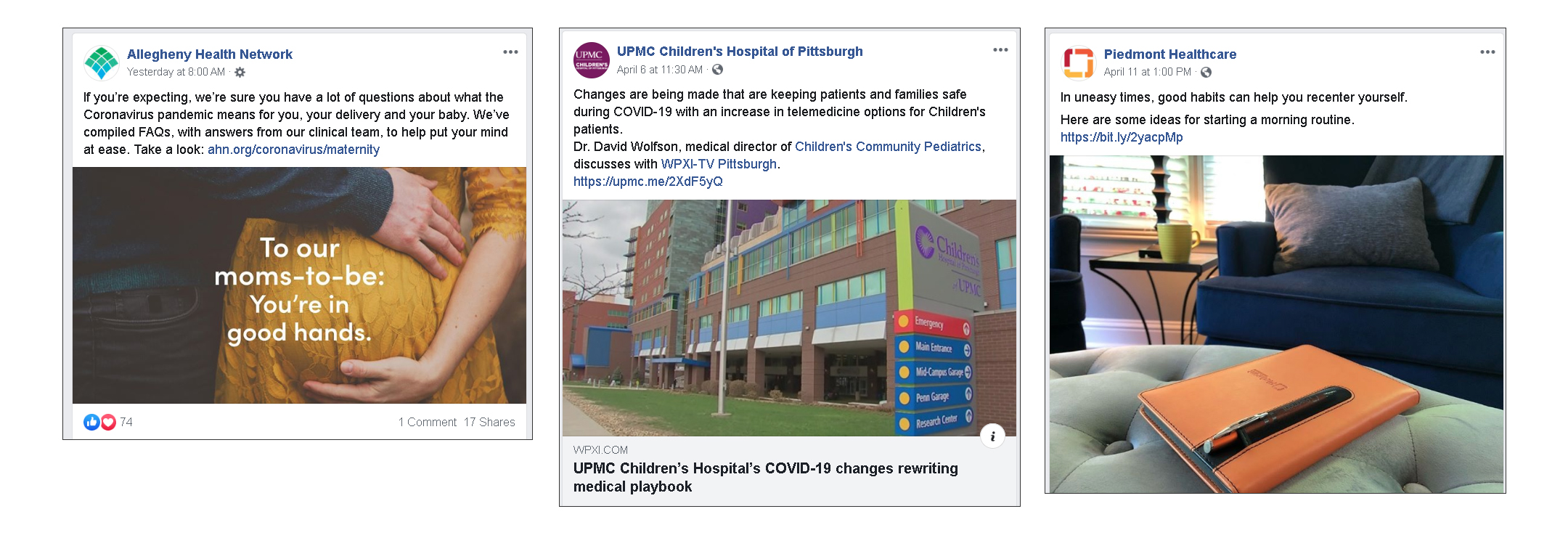The COVID-19 pandemic has healthcare marketers pivoting to patient communications, emergency and “essential” service line adjustments, and telemedicine integrations. Much of the traditional patient acquisition talk has gone out of the window as we focus on keeping both our healthcare workers safe and our patients well-cared for.
Paid search campaigns have been paused or are minimally running, television and print have come to a screeching halt, and SEO and web development projects are difficult to prioritize. Perhaps the only marketing channel humming along at a consistent pace is email communications. But that doesn’t mean that the focus on growing your practice has to stop. Yes, we may have to put some projects on hold, but now is possibly the best time to dig into what we are doing in the digital space and make sure those efforts are set up for success.
Anyone that does not continue marketing and advertising during downtimes is betting that their competitors are stopping their efforts as well. However, the odds are that at least some of your competitors will continue their campaigns or even increase their marketing efforts.
With revenue losses mounting and an uncertain economic outlook looming, it’s difficult to know where to focus your marketing budget and what activities will give you the most bang for your buck. Below are recommendations that can help you pivot your healthcare marketing strategy during this difficult time.
Hone Your SEO Strategy
If you had to reduce your paid media budget, then it becomes more important than ever to drive demand through organic sources. While many patients may be wary of spending money, they continue to be hungry for information and now have more time to conduct in-depth research online.
Now is not the time to pause your SEO efforts. If you have achieved strong organic positions, you know it was a steep climb to get there. Pausing SEO efforts will mean clawing your way back to the top once you re-start your campaigns. If your competitors continue their SEO efforts, they will be able to gain ground on you, which means you run the risk of them overtaking you in the search results. If you do pause your SEO campaigns and your competitors gain an advantage during the downtime, regaining your dominance may take a long time depending on the lead the competitors establish.
Additionally, even though the lead volume may not be as high during the downtime, the value and progress of SEO efforts still pay off once the market returns to normal. The time and the budget dedicated to these efforts won’t be lost.
Here are a few things you can do to build and reinforce your SEO strategy and stay connected to your patients:
Update Your Google My Business Listing
Throughout March, Google has been making significant algorithm changes in response to COVID-19. In an effort to connect searchers to reliable sources of information, Google was prioritizing health organization websites, like the CDC, WHO, and WebMD, that shared COVID-19 updates instead of content and news from local businesses. As a result, many businesses saw significant drops in their organic search traffic.
However, Google just launched some new initiatives to boost Google My Business (GMB) performance. Some of the new features available to healthcare providers include the ability to add:
- Telehealth as a core service within GMB.
- Links specifically for telehealth appointments (separate from regular appointment links).
- Links to announcements about COVID-19 (Google has also been automatically finding these on websites and adding them to relevant GMB accounts).
- Special posts specifically about COVID-19 (these show up in front of normal GMB posts, but are only live for 7 days. Be sure to update them as your operations change).
If possible, I highly recommend that local healthcare organizations adopt telehealth operations as quickly as possible and update their GMB listing according to the four recommendations above.
Add COVID-19 Schema Markup to Your Website
You’re now able to add structured data to COVID-19 announcements. This is still a beta feature that Google is actively developing. As of now, the COVID-19 announcement will be displayed next to the webpage’s regular snippet description. This schema can be added to important announcements regarding shelter-in-place directives, new business operations, closure notices, and event cancellations or transitions to online.
To ensure that business operations continue as smoothly as possible, you want to ensure that critical operational information is marked appropriately so it can be found by searchers.
Read more about how to add structured data to COVID-19 announcements.
Audit Technical SEO Elements
Once you’ve communicated operational changes and updated listings, it’s time to take a hard look at the technical SEO elements of your website.
- Can you improve page speed? Plug your website into Google’s PageSpeed Insights tool and see how your website performs. Users won’t wait for slow websites to load. If you’re delivering a slow website experience, Google may penalize your site and lower your rankings. Check your website’s images to start; that’s an easy way to speed up websites.
- Do your website’s meta tags accurately explain what your business does? When reviewing your meta tags, it’s important to use the keywords that will help your web page appear in search. However, don’t forget that you’re also writing for humans. Make sure that you’re concise, persuasive, and address your audience’s needs.
- Are you using internal links within your website? Internal links help you explain your website’s hierarchy to Google. They also help you pass link equity between internal pages when you link relevant content.
- Is your website using HTTPS? If not, consider making the switch. HTTPS is more secure as the data is encrypted and can’t be modified, it’s much faster, and Google uses it as a ranking factor. This guide will help you get started.
Update Your Website and Create Content
Your website is the first place that people go to learn about your business, and it’s imperative that you deliver an exceptional experience and communicate the value you offer to patients. They’re relying on you and expect you to provide clear, trustworthy information that they can depend on.
You’ve put it off for the past year—or two, but now is the time to update your website. Not your blog, but your service and product pages. These pages explain the value you bring to patients, your brand story, and what distinguishes your practice; they’re also where you tell Google what your business does. Considering the current state of affairs, they likely need to be updated. Maybe you just need to make a few tweaks to bring the copy up to speed with current industry terminology or to reflect changing operations, or maybe you want to rewrite the whole thing to be more patient-focused. Either way, consider assessing and updating your webpages now.
Once that is done, you can invest time in writing new blogs that are optimized for SEO. Do you have content for each stage of the patient’s journey? Are there common barriers that prevent leads from converting? What questions do patients routinely ask? Use this time to create educational content that answers patient questions and builds trust with your brand. Make sure that you continue to deliver valuable content that is relevant to your patients.
For situations where paid advertising isn’t an option, investing in your SEO efforts will get you the most bang for your buck in terms of driving leads. Optimizing GMB listings with new telehealth service information, updating your website and creating new blog content, and auditing and fixing your technical SEO elements are all routes you can take to improve your overall SEO strategy and drive more organic traffic during this time.
Assess and Streamline Paid Media
Hospitals and medical practices that are open for business and running well-optimized paid campaigns should continue these efforts if possible. This is especially important on Facebook; the CPM’s on the Facebook marketplace have considerably dropped in the U.S., going from an average of $5.50 at the start of March to $2.61 currently. This equates to a 53% drop and the lowest CPM’s we’ve seen in the industry in over 24 months.
Review All Ad Copy:
Before launching any new advertising campaigns, you should audit all existing campaign creatives. This is an unprecedented time that is affecting everyone differently. You need to view your ads through the lens of the COVID-19 pandemic. Is your ad imagery and copy appropriate? Are you being sensitive to your customer’s new challenges and fears?

Make sure that the creative you’re using is softer, sensitive to the times we’re living in, and doesn’t come across as opportunistic. Maintain your brand’s voice, while keeping the sensitivity of this crisis in mind. Avoid images of people touching, shaking hands or hugging. Content that exudes positivity and promotes mental health—whether through imagery or language or even color choice—will be better received.
Your ads should also reflect how your company is responding to this new environment. If you’ve closed in-store sales or office visits, don’t run ads that tell people to visit you in-person. Make sure ad copy reflects current operations and ensure that you have consistency across all channels.
Reduce Unnecessary Spend:
Before you make dramatic cuts across the board, I recommend you take a step back and review your campaigns’ performance. You need customers now more than ever; so focus your budget on your best-performing ads and consider cutting those that historically haven’t performed well. You can also pause top-of-the-funnel campaigns and increase investments in branded keywords and bottom-of-the-funnel keywords that drive conversions.
You may also want to cut ad campaigns for product lines or services that don’t bring in considerable revenue. Identify the service lines that are of most value at this time and focus your budget on them.
Identify Growth Opportunities:
With Facebook seeing a huge uptick in usage, now is a great time to invest in upper-funnel tactics like Facebook Ads, where there is an opportunity for advertisers to see less competition and increase their market share.
Most people are stuck at home, which means streaming is at an all-time high right now. This is an excellent opportunity to increase investments in in-stream advertising. Whether it’s Netflix, YouTube, or Hulu, all of these services have millions of eyeballs on them right now. Engaging video ads will help you connect with your audience and keep your brand top of mind.
Plan for the Future:
With a smaller media budget to manage, here are a few projects you can work on in the meantime:
- Create and schedule new ad copy for special events—take advantage of this “down” time and plan new ad copy for events or promotions that occur late 2020.
- Update ad copy for future creative testing—schedule ads to begin testing in the summer months when volume increases and conversion rates improve.
- Expand upon new keyword categories that you’ve been putting off—these don’t necessarily have to launch now, but you’ll be ready to test when volume kicks back up.
- Prepare new awareness display campaigns to ensure you’re building and maintaining awareness—you don’t want your audience to forget about you. While they may not be able to schedule a visit now, you’ll stay top of mind until they’re able to.
Continually Improve and Optimize Conversion Rates
Marketers can use this lull in media spend to get their house in order regarding user experience and conversion rate optimization (CRO). A typical website conversion rate is about 2.35% on average, but companies with established CRO programs see 3-5x higher conversion rates than average, which in turn drives down the cost-per-acquisition.
Optimized media can only be successful when driven to an optimized user experience. Often gains in conversion rate improvements from A/B and multi-variate testing far outstrip the impact of media optimizations, such as refining audiences, launching new copy, or applying keyword expansions.
Test, Test, Test
Creative testing should be happening year-round, but there’s no better opportunity than now. Use this time to learn more about your audience and better understand their behaviors when they are responding to creative. Test campaigns with video vs. carousel, stock footage vs. animated, and solution-based messaging vs. product-based messaging. The knowledge you take away from this can inform future decisions and campaigns and hopefully lead to bigger, better conversions.
Even if you’re not running paid media and driving traffic from those channels, you can use tools like Hotjar and Full Story to set up quantitative and qualitative data collection centered around improving user experience by analyzing Organic, Direct and Referral traffic sources. Once you complete the data collection phase and gather the requisite data via heatmaps, session recordings, and polls, you can derive insights from the current user experience to help guide your CRO testing roadmap.
The roadmap should focus on prioritizing the highest impact tests first; these are usually larger changes like page structure and changing the most prominent and important content. Only large companies with millions of visitors should focus on minute changes like changing the color of a button. As part of planning out tests, traffic estimations and test timing should be devised so that there is an understanding of how many tests can be conducted over a certain period.
Once planning is complete, marketers can then implement tests using tools like Google Optimize. Optimize is a powerful tool that allows for A/B tests, multivariate tests, personalization, and more. Data from Google Optimize experiments are ported into Google Analytics so that tests can be monitored and results viewed in almost real-time.
Once the test is complete and statistical significance has been reached, marketers should perform a test wrap up analysis and use the results to either (A) inform future tests or (B) deploy permanent variants of improved user experiences.
Optimize Your Website’s User Experience
Similar to the above, this is the time to find out what is—and isn’t—working for website users. Utilizing AB tests to learn what elements (such as your call-to-action) entice a visitor to contact you is going to benefit you in the long-run. It’s also the perfect time to audit your site according to the best design and UX practices.

If website traffic is down right now, why not use the time to make adjustments that will help future patients navigate more easily? By focusing on conversion rate optimization, you’ll make sure that every website visit counts now and in the future.
This can add long-term value by:
- Lowering your cost-per-acquisition (CPA) on all paid channels by converting those high-cost clicks at a higher rate.
- Improving organic rankings by telling algorithms that you have the best content with the best user experience.
Wondering where to start?
Ask yourself, your team, customer service—what is the biggest pain point that customers have? Start there and make small improvements now that will pay off big in the long-term.
Improve Your Analytics
Another thing that marketers can do during the downtown is to connect the dots with their digital marketing efforts and their lead outcomes. Even if marketers have tricky or custom systems, tools like Zapier and Google Tag Manager make it possible to tie a paid social click or paid search phone call to a sale or outcome tracked in a CRM system.
While every set up is different when it comes to connecting datasets and visualizing your data, a common way of tying a marketing exposure to an offline event is to capture the Google Analytics ID (a cookie that identifies the user) during a web session and then pass the ID into your CRM system through either hidden form fields (for form submissions) or via a call tracking tool, like CallRail for phone calls. The GA Client ID has a host of marketing information attached to it via Google Analytics reports, such as the source and medium of the session, the keyword that was searched (if PPC), the ad content from a paid social campaign (if using UTMs) that can then be matched to the customer record and customer value.
If matching on the GA Client ID is done correctly, marketers are able to tie a session on the website to a web lead and then to an opportunity won or lost. Once they can do that, they’ll be able to assign a return on ad spend (ROAS) value to marketing efforts by dividing client revenue driven by advertising dollars spent. This ROAS model makes it far easier for marketers to justify digital marketing efforts and spend on acquisition channels than historical CPA models where unknowns of lead quality and eventual outcomes make it much harder to say what an appropriate acquisition cost should be.
You should also determine whether your tagging and tracking is set up in an ideal manner. Are you using Google Tag Manager to organize pixels and goals? Or are your tags all card-coded on the site? Do you have proper goal tracking in all of your engines and are they speaking to each other to tell a holistic story of the patient journey?
Take the time now to get your analytics in order so you can make educated decisions moving forward.
Keep Looking Ahead
While the COVID-19 pandemic presents unprecedented challenges for healthcare marketers, you can pivot your marketing strategy in response. Now is the time to strengthen your relationship with your patients through empathetic communications, build long-term loyalty through educational content, and nurture customers in new ways. We’ll get through this, and when we do, your practice will be poised to grow.
Stay well and let us know if there’s anything we can do to help.

